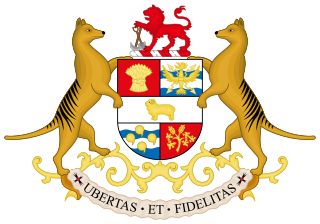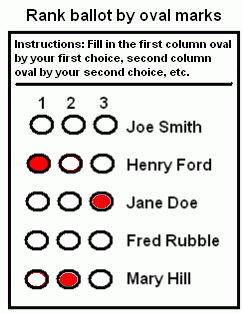
Proportional representation (PR) refers to any type of electoral system under which subgroups of an electorate are reflected proportionately in the elected body. The concept applies mainly to political divisions among voters. The essence of such systems is that all votes cast – or almost all votes cast – contribute to the result and are effectively used to help elect someone. Under other election systems, a bare plurality or a scant majority are all that are used to elect candidates. PR systems provide balanced representation to different factions, reflecting how votes are cast.

The single transferable vote (STV) or proportional-ranked choice voting (P-RCV) is a multi-winner electoral system in which each voter casts a single vote in the form of a ranked ballot. Voters have the option to rank candidates, and their vote may be transferred according to alternative preferences if their preferred candidate is eliminated or elected with surplus votes, so that their vote is used to elect someone they prefer over others in the running. STV aims to approach proportional representation based on votes cast in the district where it is used, so that each vote is worth about the same as another.
Electoral systems of the Australian states and territories are broadly similar to the electoral system used in federal elections in Australia.

The House of Assembly, or Lower House, is one of the two chambers of the Parliament of Tasmania in Australia. The other is the Legislative Council or Upper House. It sits in Parliament House in the state capital, Hobart.
In the Parliament of Australia, a casual vacancy arises when a member of either the Senate or the House of Representatives:
BC-STV is the proposed voting system recommended by the Citizens' Assembly on Electoral Reform in October 2004 for use in British Columbia, and belongs to the single transferable vote family of voting systems. BC-STV was supported by a majority of the voters in a referendum held in 2005 but the government had legislated that it would not be bound by any vote lower than 60 percent in favour. Because of the strong majority support for BC-STV, the government elected to stage a second referendum in 2009, but with increased public funding for information campaigns to better inform the electorate about the differences between the existing and proposed systems. The leadership of both the "yes" side and the "no" side were assigned by the government. The proposal was rejected with 60.9 percent voting against, vs. 39.1 percent in favour, in the 2009 vote.
The single transferable vote (STV) is a proportional representation system that elects multiple winners. It is one of several ways of choosing winners from ballots that rank candidates by preference. Under STV, an elector's vote is initially allocated to their first-ranked candidate. Candidates are elected (winners) if their vote tally reaches quota. After the winners in the first count are determined, if seats are still open, surplus votes — those in excess of an electoral quota— are transferred from winners to the remaining candidates (hopefuls) according to the surplus ballots' next usable back-up preference.
Historically, the single transferable vote (STV) electoral system has seen a series of relatively modest periods of usage and disusage throughout the world; however, today it is seeing increasing popularity and proposed implementation as a method of proportional representation and a goal of electoral reform. STV has been used in many different local, regional and national electoral systems, as well as in various other types of bodies, around the world.
Instant-runoff voting (IRV) is a ranked voting method used in single-winner elections. IRV is also known outside the US as the alternative vote (AV). Today it is in use at a national level to elect the Australian House of Representatives, the National Parliament of Papua New Guinea, the President of Ireland and President of India. In Australia it is also used for elections to the legislative assemblies of all states and territories except Tasmania and the Australian Capital Territory, and for the Tasmanian Legislative Council.
There are a number of complications and issues surrounding the application and use of single transferable vote proportional representation that form the basis of discussions between its advocates and detractors.
In politics, a casual vacancy is a situation in which a seat in a deliberative assembly becomes vacant during that assembly's term. Casual vacancies may arise through the death, resignation or disqualification of the sitting member, or for other reasons.

A by-election for the Tasmanian House of Assembly was held in the Division of Denison in the Australian state of Tasmania on Saturday 16 February 1980.

The Wright system is a refinement of rules associated with proportional representation by means of the single transferable vote (PR-STV) electoral system. It was developed and written by Anthony van der Craats, a system analyst and life member of the Proportional Representation Society of Australia. It is described in a submission into a parliamentary review of the 2007 Australian federal election.

Instant-runoff voting is a single-winner, multi-round elimination rule that uses ranked voting to simulate a series of runoffs with only one vote. In each round, the candidate with the fewest votes counting towards them is eliminated, and the votes are transferred to their next available preference until one of the options reaches a majority of the remaining votes. Instant runoff falls under the plurality-with-elimination family of voting methods, and is thus closely related to rules like the exhaustive ballot and two-round runoff system.
Proportional Representation Society of Australia Inc. is an electoral reform organisation in Australia. Its membership includes people that have successfully promoted electoral reform.

An electoral or voting system is a set of rules used to determine the results of an election. Electoral systems are used in politics to elect governments, while non-political elections may take place in business, non-profit organisations and informal organisations. These rules govern all aspects of the voting process: when elections occur, who is allowed to vote, who can stand as a candidate, how ballots are marked and cast, how the ballots are counted, how votes translate into the election outcome, limits on campaign spending, and other factors that can affect the result. Political electoral systems are defined by constitutions and electoral laws, are typically conducted by election commissions, and can use multiple types of elections for different offices.

Ranked voting is any voting system that uses voters' rankings of candidates to choose a single winner or multiple winners. More formally, a ranked system is one that depends only on which of two candidates is preferred by a voter, and as such does not incorporate any information about intensity of preferences. Ranked voting systems vary dramatically in how preferences are tabulated and counted, which gives them very different properties. In instant-runoff voting (IRV) and the single transferable vote system (STV), lower preferences are used as contingencies and are only applied when all higher-ranked preferences on a ballot have been eliminated or when the vote has been cast for a candidate who has been elected and surplus votes need to be transferred.
Nicholas Adam Street is an Australian politician. He was elected to the Tasmanian House of Assembly in a countback conducted on 1 March 2016, to fill a vacancy caused by the resignation of Paul Harriss, and served until his defeat at the 2018 state election. He was then re-elected on 6 February 2020, filling a vacancy caused by the resignation of Will Hodgman.

Hare–Clark is a type of single transferable vote electoral system of proportional representation used for elections in Tasmania and the Australian Capital Territory. It was one of the first uses of the Gregory method for transfers of winner's surplus votes.

The 2026 Tasmanian local elections will be held in October 2026 to elect the councils, mayors and deputy mayors of the 29 local government areas (LGAs) in Tasmania, Australia.







